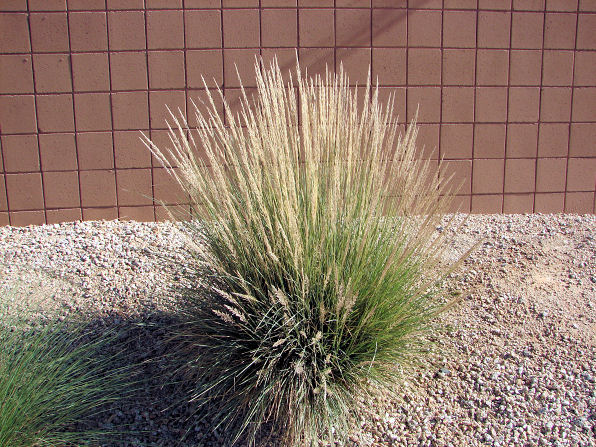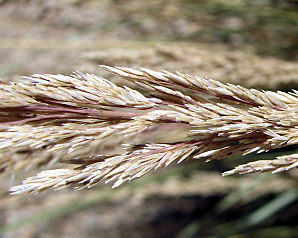Xeriscape Landscape Plants & Flowers
For The Arizona Desert Environment.
Pictures, Photos, Images, Descriptions, & Reviews.
Mexican Thread Grass, Stipa tenuissima.
We Are Proud Of Our SafeSurf Rating!
Click On Any Of The Following Links By Amazon.Com
For Books, & Videos About Wildflowers Of Arizona & The Southwest USA. No Obligation!
 |
| Mexican Thread Grass, Stipa tenuissima. Photo December 11, 2006. Peoria, Arizona. |
|---|
| Mexican Thread Grass. Stipa tenuissima. | Mexican Thread Grass. Stipa tenuissima. |
|---|---|
 | |
| Mexican Thread Grass. Stipa tenuissima. | Mexican Thread Grass. Stipa tenuissima. |
Mexican Thread Grass. Stipa tenuissima,Grass Family ( Poaceae ), Mexican Thread Grass. Also called Feather Grass, Silky Thread Grass, Mexican Feather Grass, Mexican Needle Grass, Pony Tails, Nassella tenuissima. We wish to thank Wikipedia, the free encyclopedia for some of the information on this page. We share images and information with Wikipedia. Reclassified as Nassella teniussuma. Nassella tenuissima is still sold under the name Stipa tenuissima. This grass moves at the slightest breeze. Mexican feather grass is great for erosion control on sunny slopes. It reseeds itself. To prevent any offspring, cut back seed heads before they ripen. Run a rake through it in late winter to early spring to take out dead grass. A neat, compact, perennial grass, this has lots of close-packed, stiff, thread-like stems forming a strongly horizontal shape about 60cm (2ft) tall. In summer, plants are covered with masses of elegant pale feathery seed-heads which are held a little above the foliage. These can be cut and dried when first opened for use in winter arrangements indoors. Alternatively they make a useful winter food source for finches and other seed-eating birds. It tolerates alkaline soil; extremely drought tolerant. Moderate to little water, cannot tolerate poorly-drained soils.
Quick Notes:
Height: Height normally about 30 inches tall. Will also spread to about 12 inches.
Flowers: Feathery, starting out green, then turning a buff tan color.
Flowering Time: Phoenix Arizona. Mid August - September.
Seeds: Its fruits are caryopses. The seed head is dark purple; narrow at the base and becoming loose and open at the top of its 6 - 12 inch length.
Leaves: Simple, narrow, tightly rolled, green leaves.
Found: The USDA claims it is native to the USA (CA, NM, TX). Also found in northern Mexico in the states of Baja Norte, Chihuahua, Coahuila, Durango, Nuevo Leon, Sonora, Tamaulipas, Zacatecas. And southern Mexico in Oaxaca, & Puebla. Also Argentina.
Hardiness:
Soil pH requirements:
Sun Exposure:
Elevation: 2,500 - 7,000 Feet.
Habitat: Rocky open slopes, shallow woodlands and forest openings up to an elevation of 7,000 feet.
Miscellaneous: Great xeriscape plant. Photos Taken December 11, 2006. Peoria, Arizona.
More Details:
Culms: Erect, solid, 10 to 40 inches tall, glabrous, purplish at the nodes. They are in clumps or sometimes just a few together.
Blades: Numerous blades, flat, from 2 to 12 inches long, scabrous above and on the margins, smooth beneath. Tiny hairs grow out of tiny bumps on the blade margins, especially near the ligule.
Sheaths: Usually shorter than the internodes, striate, glabrous below to somewhat pilose above. The collar is frequently pilose on the margins.
Ligules: Very short fringed membrane, truncate.
Inflorescence: A panicle, 3 to16 inches long, with 20 to 60 spike-like branches, each one-sided and 1/2 to 3/4 inch long. The individual branches are angled to one side of the rachis and they hang down.
Spikelets: There are 3 to 8 spikelets per branch with one perfect floret and one imperfect floret. Lemma has three short, unequal awns.
|
We Are Proud Of Our SafeSurf Rating!
Click On Any Of The Following Links By Amazon.Com
For Books, & Videos About Wildflowers Of Arizona & The Southwest USA. No Obligation!
| © 1966 - Present, Audrey, Eve, & George DeLange |
